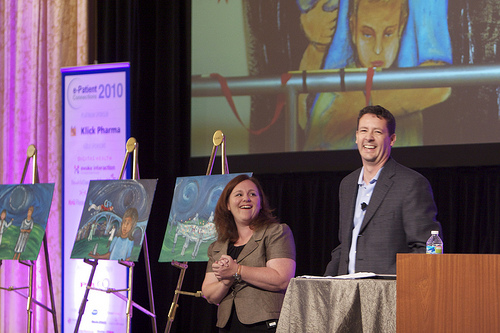I began painting at medical conferences in the fall of 2010. Kevin Kruse who ran ePatient Connections in Philadelphiaasked me if I would deliver a keynote speech. He also knew I painted murals, but wondered if I would be willing to paint on site. Then we could auction the canvases to raise money for the charity of my choice. I chose to donate to Ivymount School as did my husband in lieu of flowers upon his death. The school has has been such a help to my son Freddie and other children with special needs. It was wonderful experience painting on site. Since that event, I have asked to paint at virtually every venue I have attended. I have painted in Australia, Korea and throughout the United States. I have shown up at a great deal of health policy meetings with easel in hand.
But why do I do this?
A Visual Memory of the Day
So many conferences have a similar look about them when photographed. We usually meet in ballrooms; nicely dressed men and women stand behind podiums. Most people show lovely smiles to the cameras, regardless of whether or not their slide deck was filled with horrific statistics or pleasing results. Good or bad, the paintbrush can depict content in a different way. A painting can capture in one quick glance thoughts and feeling that may take an author pages to describe.
Embracing “Free Play/Creative Thinking”
I worked in a preschool for many years. If you are familiar with a preschool room layout, you know there are centers. These centers allow each child to choose a path that supports creative thought, greater understanding of self and the world around them. Some centers use blocks and puzzles, some dress up, some reading/listening and some centers have easels with paint. Have you ever heard the wonderful Tedtalk by Sir Ken Robinson? He says we peak in creativity between ages 4-5. I wonder if we peak then because of the world inside our mind or is it because of the world before our eyes? At most medical conferences (even the ones with the word innovation in the title), I see only one center open: the reading/listening one. I am providing a different learning experience as I set up my easel and paint. Often a small group of people surrounds my easel. Some of them say they wish they could join me. They think in pictures too. Their inspirational thoughts are often relegated to a doodle in the margins of a conference hand out. Sometimes they do join me and paint at my side. I hope some day to attend an event at Health Human Services and see a row of easels behind the last row of chairs.
Life is messy and people are unique
I paint from the patient view when I listen to content at a conference. So my painting reflects this worldview. And gasp! I have dirty brushes and permanent pigments (though I have yet to have bad spill in the past two years). I offer some unique challenges for conference organizers. I need to hear content to paint, so upon occasion the venue has strung phone line down a long hall to enable me to paint over a tile floor. Other venues are fine with the drop cloth I provide. I have painted from the front of the room near the speaker and had the audience follow my brush as much they follow the keynote’s spoken word. I have painted in the back of the darkened room; my canvas lit with my trusty smart phone. As we talk about truly inviting the patient to the table of discourse, we must embrace a willingness to think outside the box of traditional expectation.
The Salon
At events that are fairly open in their presentation and organization, I find a community forms around the easel. You see there are many of us in the health tech world who are on the ADHD side, and sitting still is a special type of torture. Well, I stand at my easel and often others stand beside me in the room. I give folks permission to stand out or do things differently by doing things differently myself. As the day progresses people will often drag chairs over and tweet about the event from the art salon that forms around the easel.
Welcome to the Table
I have gone to great deal of events and health policy meetings that are in hotel basements or upper rooms of conference facilities. The tables are arrange in the traditional u or box shape and our names appear on table tents Here I watch the attendees and speakers eyes light up as they realize I am painting their thoughts as I share my own. They come talk to me at my easel and thank me for spreading the word about their work to an ever-greater audience. They tell me how honored they feel to know their words are reflected in paint.
Art as an action
At certain events for some reason or another it is impossible to paint. I always attend such meetings with a sense of sadness and loss. Sometimes, I will show up to a meeting where I am told painting is not an option. Then I must decide. Do I set my easel to the side, sit within my chair and listen quietly? Or do I leave the venue and paint upon the street? I have done both. I meet such interesting folks on the street. I talk with both attendees and a great deal of patients then. The patients had not been invited into the conference but have the most interesting things to say about health and medicine. And I do not mind painting on the street. It reminds me of painting 73 Cents, and after all that is how my painting advocacy began.
